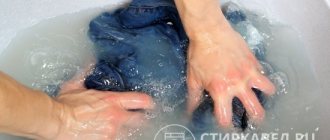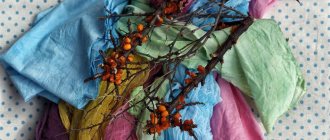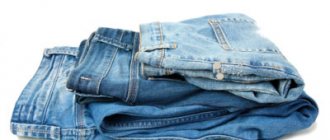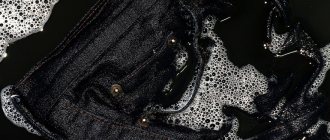Coloring agents
It’s easy to navigate the variety of fabric dyes if you know exactly what color you want to get and how durable it should be:
Read also: What you need to know about toothpaste
- Aniline dyes are universal products intended for updating denim or other dense fabric.
- Powder paints are permanent dyes in powder form that must be diluted in water. Powders are available in a narrow range of colors. Recently, the new Dilon powder has been gaining popularity, offering pleasant shades.
- Acrylic. Acrylic paints are characterized by increased durability and a variety of color palettes.
- Potassium permanganate is one of the most inexpensive remedies. Requires certain skill and experience.
- Blue is present in most housewives’ homes in the form of liquid or powder. Linen is tinted blue to give white fabric a fresh look. It's easy to update jeans with blue, but you should prepare for constant touch-up.
- Alternative means - hair dye, aerosol sprays, dyes for ordinary fabric. Jeans are not intended for dyeing, so it is difficult to navigate the palette of shades, and durability cannot be expected.
Most of the products described can be found in the industrial goods department, as well as in fabric stores and boutiques for needlewomen. Potassium permanganate used to be purchased at the pharmacy, but recently it has become problematic to buy it. It is worth trying to look for the chemical in gardening stores or veterinary pharmacies. It is potassium permanganate and blue that are the most economical means for dyeing trousers.
Before using any coloring preparation, you should carefully read the instructions on the package. The more accurately all the manufacturer’s recommendations are followed, the more likely it is that a decent result will be obtained at the end of the procedure.
Coloring agents
It’s easy to navigate the variety of fabric dyes if you know exactly what color you want to get and how durable it should be:
- Aniline dyes are universal products intended for updating denim or other dense fabric.
- Powder paints are permanent dyes in powder form that must be diluted in water. Powders are available in a narrow range of colors. Recently, the new Dilon powder has been gaining popularity, offering pleasant shades.
- Acrylic. Acrylic paints are characterized by increased durability and a variety of color palettes.
- Potassium permanganate is one of the most inexpensive remedies. Requires certain skill and experience.
- Blue is present in most housewives’ homes in the form of liquid or powder. Linen is tinted blue to give white fabric a fresh look. It's easy to update jeans with blue, but you should prepare for constant touch-up.
- Alternative means - hair dye, aerosol sprays, dyes for ordinary fabric. Jeans are not intended for dyeing, so it is difficult to navigate the palette of shades, and durability cannot be expected.
Most of the products described can be found in the industrial goods department, as well as in fabric stores and boutiques for needlewomen. Potassium permanganate used to be purchased at the pharmacy, but recently it has become problematic to buy it. It is worth trying to look for the chemical in gardening stores or veterinary pharmacies. It is potassium permanganate and blue that are the most economical means for dyeing trousers.
Before using any coloring preparation, you should carefully read the instructions on the package. The more accurately all the manufacturer’s recommendations are followed, the more likely it is that a decent result will be obtained at the end of the procedure.
Where to begin?
In Soviet times, the range of clothing was not particularly diverse, so for our grandparents such a procedure as dyeing pants with their own hands was par for the course. Reliable and inexpensive means - blue and white - helped to stand out. It was then that the word “varenki” appeared, which was used to describe fashionably bleached jeans.
Modern clothing stores do not know the word “shortage”; you can find jeans in any colors and textures, with or without decoration. But even today, many needlewomen are happy to use grandmother’s proven recipes, wanting to extend the life of their favorite pants, with which they have gone through both fire and water.
So, how to dye jeans yourself? First of all, two questions need to be resolved:
- How can you dye jeans?
- How to do this - manually or using a washing machine?
Let's look at each of them in more detail.
Useful tips
If you are going to paint any item of your wardrobe for the first time, then consider the following nuances:
- Only natural cotton, wool or linen are dyed evenly. When dyeing other fabrics, there is a possibility that the clothes will be dyed in pieces.
Important! If you are not sure about the composition of the fabric and do not want to take risks, try test dyeing - dye a small piece of fabric specifically from your product.
- You only need to paint a thoroughly washed product without stains, otherwise the paint will lie unevenly.
- Clothes are placed in the machine wet - this way they are better dyed.
- If you want to dye an item a darker color to hide a stain, it will still be visible because stained clothing is not dyed evenly.
Important! Rust stains are practically impossible to paint; it is easier to decorate them in some other way, for example, by sewing on an applique.
- It is unlikely that you can get a black one from a white item right away. You will most likely have to do several paint jobs before you get the shade you want.
- A freshly dyed item will fade, so it is not recommended to wash it with other items for up to five washes.
- It is not recommended to paint synthetics, since they do not stain evenly, no matter what paint manufacturers write. But if you really want to experiment, then do a test dyeing on a piece of material, and only if the result is positive, paint the entire thing.
- The color indicated on the package is obtained if you dye a white item. But if your product is a different shade, then at the end you risk getting a completely unexpected color, albeit in a similar color scheme.
- As a rule, the threads with which the product is sewn are not dyed, so think in advance about how they will be combined with the new color of the clothing.
- If you add conditioner while painting, the paint will not apply evenly and your clothes will become stained.
- Jeans are dyed on both sides.
Important! If you are going to update the design of your item in this way, be very careful about choosing the right product. Find out all about the best fabric paints.
How to increase your chances of success?
By choosing a pigment suitable for the fabric and properly preparing the jeans:
- Synthetic fibers are not dyed with substances for cotton and linen. Is there a high percentage of artificial thread in the material of the pants? The new tone will fall unevenly.
- The paint is selected taking into account the maximum permissible temperatures when washing the product. A number of products are designed for use when water is heated to 90 degrees. But at this temperature, some jeans may shrink or stretch 1.5-2 sizes.
Are you unplugging your washing machine?Oh yes! No
- Stripes and logos are pre-stripped - the color of leather or fabric appliqués looks less beautiful after painting.
- Wanting to return jeans to their original attractiveness, they take into account their weight without water. A number of manufacturers produce paints in packaging designed for use on items weighing no more than 500-600 g in dry form.
- Before processing any dye, jeans are cleaned of all types of contaminants. Substances in stains from fat, berries, sauces will interfere with uniform color. In the future, in the problem area, the color of the fabric will be darker or lighter than the rest of the material.
- Washing jeans is a must before restoring their color. To ensure that the conditioner and fiber softeners in the gel or powder do not affect the uniform absorption of coloring pigments in the future, the pants are moistened and rubbed with ordinary household soap or a soap with a whitening effect before washing.
- To evenly distribute the pigment throughout the fabric of already clean and wrung out trousers, soak them for 10-15 minutes in a weak bleach solution based on chlorine-free powder, or in water and anti-stain soap (if this was not done at the washing stage). Before painting, jeans are thoroughly rinsed.
Jeans
Preparing for coloring
Before starting the procedure, things are washed. When you dye clothes without first washing them, streaks appear on the fabric. The clothes are carefully inspected, checking for stains. If necessary, they are removed with a suitable means.
If dirt is not removed, it is better to choose a dark color for painting. Light shades will not be able to disguise stains.
Read also: Accused of something you didn’t do
Buttons, rivets and other accessories are removed. After the procedure, they may change color or rust may appear.
Closeup group of blue jeans inside the washing machine.
To get the effect of uneven coloring, things are tied together. The density of the knot determines how much the fabric inside it will be dyed. If the bundle is strong, the contrast of colors will be sharp; with a weak bundle, a smooth transition of shades will result.
Top Loading Machine vs Front Loading Machine
Top load washing machines are much easier to use when dyeing fabrics because the lid can be opened at any time during the cycle and dyes or auxiliary materials can be added as desired.
However, front-loading washing machines are much more water efficient. Some front-end washing machines, especially in Europe, have heaters that allow fabrics to be dyed or washed at temperatures much higher than tap water can reach. The best front-loading washing machines have dispensers that allow you to add dyes and additives (such as salt and baking soda). This will help you forget about the main problem - that you cannot open the door during the wash cycle.
How to dye pants by hand
For a procedure carried out without the participation of a washing machine, you will have to prepare a larger container - an enamel bucket, a basin, a large saucepan or similar large dishes. Large sizes are needed in order to be able to straighten the fabric as much as possible during dyeing, otherwise the jeans will acquire bright folds and stains.
For manual coloring, follow a simple sequence of actions:
- Dilute the paint in water. Color saturation is adjusted independently depending on the desired result.
- If necessary, add salt and soda (some manufacturers themselves indicate in the instructions on the packaging the importance of this addition, which allows you to fix the color).
- The dye is poured into a bowl, where another 5-8 liters of water are then added, and then the jeans themselves.
- Cook a pan or basin with jeans on the stove for an hour. Temperature – from 86 degrees. The contents of the container are stirred periodically.
- After an hour, the jeans are removed from the solution, then rinsed in warm and cool water alternately.
- The trousers can be soaked briefly (up to 20 minutes) in vinegar water to preserve the color.
Methods for dyeing denim
Washing machine
Hand dyeing
This method is especially convenient for coloring, in which you need to control the brightness of the color, as well as create interesting transitions from the brightest shade to the lightest. However, only enamel dishes can be used for this method.
- First, the dye is prepared and diluted in the required quantity in a separate container.
- The paint is mixed with water from 7 to 10 liters, depending on the volume of the product, and the liquid is heated on the stove almost to a boil.
- Jeans are already dipped into hot water and boiled for about an hour.
- The item is rinsed alternately in hot and cold water; during the last rinse, vinegar is added to fix the resulting shade.
- Finally, the dyed jeans are washed optimally in the machine, with the addition of softening agents.
After using any coloring agents, it is necessary to ensure proper care of the updated item. Despite the color being fixed at first, it can change for the worse due to many factors, incorrect washing or ironing mode, or improper drying.
To maintain the desired color, you must follow a few simple rules:
- For the first few washes, wash dyed jeans separately from other items, and do not use them at high temperatures.
- Eliminate treatment with laundry soap, use of conditioners and use the powder only for colored laundry
- Do not dry jeans in direct sunlight or on heating appliances
If you follow these simple rules, the painted item will not change its color and will last much longer.
Dyeing jeans in the washing machine
So, how to dye pants or other clothes in the washing machine? The item has been washed, the stains have been removed, the paint of the desired color has been purchased, what to do next? Detailed below:
- Dilute the paint according to the manufacturer's instructions.
Important! If the manufacturer indicates that you need to add salt, then we add salt; if it doesn’t indicate, it means you haven’t forgotten, but simply don’t need it.
- Pour the resulting solution or liquid paint into the powder compartment and add salt there if the manufacturer insists on it.
- Run a long cycle with high temperature.
- At the end of the cycle, wash your clothes as usual with detergent and conditioner. If necessary, use our guide on how to wash jeans in a washing machine.
- Rinse in vinegar to ensure color fastness.
Alternative techniques
Depending on what dye you decide to dye your jeans with, the procedure may vary slightly. Therefore, if you use improvised or home remedies, study some of the features of coloring.
Acrylic paint
When choosing what to dye your jeans with, you should opt for acrylic dyes, which penetrate deeply into the fibers of the fabric and are firmly fixed there. Even black jeans can be dyed this way, but the color will not be uniform; acrylic is used for design decisions when it is necessary to create a pattern on the fabric. To ensure longevity of the result and to avoid cracking of the paint, you should avoid layering large amounts of acrylic. It is better if you first apply an outline to the product with a pencil, and then proceed to further coloring.
In order for the result to exceed expectations, you need to take into account the following recommendations:
- work quickly with the brush to avoid unnecessary dried contours;
- do paint tests on a piece of rough fabric;
- go from light to dark shades;
- the contour is drawn with a thin brush with soft bristles;
- For painting, choose brushes with synthetic bristles.
When the drawing is ready, you should wait 10-15 hours and iron the pants, turning the jeans inside out.
Painting on jeans with acrylic paints
Ordinary acrylic paint will be useful for both professional artists and fashionistas to create a masterpiece from boring trousers. Nowadays it is quite easy to find any shades on the shelves, but if this is not enough, you can get a new one - the colors mix well.
The color should be applied with a brush onto pre-washed, dried and ironed material. It is better to draw the outlines of the design in advance with a pencil or fabric chalk so as not to get lost in the process. Thick cardboard should be placed inside the trouser leg so that the paint does not print on the other side.
Note! Although acrylic paint eats into the fibers quite deeply, with frequent washing the image will quickly lose its saturation, so it is not recommended to revive pants for everyday wear.
When everything is ready, you need to let the acrylic dry. This may take 12-16 hours. Then the place where the paint is applied should be ironed so that the design lasts longer.
Plastisol paints
Fluorescent inks are more often used in screen printing. However, dye manufacturers have released variations of phosphor-based toners specifically for handmade lovers, which allows you to work with pigments at home.
Creating a glowing image is not difficult, you just need to know the sequence of actions:
- clean pants from dirt, wash them;
- Apply the first layer of the design with a synthetic brush;
- subsequent layers are applied after the previous ones have completely dried.
When finished, you should leave the jeans at rest for 2-3 hours. The paint looks brighter if the base is light colors. The glow is charged from daylight by accumulation, 20-30 minutes is enough.
The effect of faded jeans using whiteness
While some are trying to update their jeans by returning their color, others dream of making them old. In the USSR, denim jeans were popular, and fashion, as you know, is cyclical and tends to come back.
You can get this original effect using regular white.
“Varenki jeans” using whiteness
When trying to get jeans with a unique coloring, you must take into account that chlorine weakens the fibers of the fabric. Therefore, the item must be treated with diluted white, not concentrated. A glass of liquid bleach is enough for a 10-liter bucket.
More details:
- Twist the washed and wrung out jeans legs in different directions. It is better to secure the turrets and knots with a stronger thread. If you secure the twists with rubber bands, then in hot water the latter may stretch and will no longer secure sections of the fabric.
- After immersing the trousers in chlorinated water, keep the container on the fire for a quarter of an hour.
- Immediately after boiling, remove the jeans and rinse thoroughly.
Good old blue
Peculiarities. With the help of blue, you can add brightness and richness to the product. But you won't be able to change the color scheme. Blue is used only for those things that were originally blue.
- Fill a bucket or basin with warm water.
- Pour blue into the liquid (the concentration depends on your preference).
- Add three tablespoons of regular table salt to achieve a fixing effect.
- Immerse the product in the solution for two hours, remembering to turn it over periodically.
This simple method, despite the fixing saline solution, is still short-lived. The bluing will wash off after about two or three washes.
Selection of paint for jeans
Again and again we will repeat the golden rule about reading instructions. There are so many dyes sold that it would be pointless to describe each variety in detail - no one will ever remember it. A single misstep can transform your modest everyday jeans into a stage costume, or from college party king to an overgrown Ohio high school senior.
In order to somehow protect you from such unplanned transformations, let’s go over the basic principles of selection and types of paints to dye jeans blue at home.
Soluble or insoluble?
Simply put, powder or solution? If you are a lazy and undemanding person, the choice in favor of a ready-made liquid reagent is quite obvious for you. But it's not that simple. Coloring and coloring are different. Some people want to change the color of their jeans, others just want to freshen them up.
Manufacturers have learned to take this point into account and began to produce dyes intended for different purposes. It is generally accepted that:
- liquid dyes for jeans are better for modest plans to restore the color at least a few washes back;
- To completely change the color or add new shades to the color scheme of the pants, it is better to choose a powder dye composition for jeans.
Aniline dyes
At first glance, the simple procedure for dyeing fabrics, as you have seen, is full of many subtle nuances in which it is easy to get confused. How not to make a mistake with the shade, with the type of dye for jeans, with the method of heat treatment?
Help in choosing a shade are color tables, which are sometimes supplied with instructions for dyes. In them you can see how rich shades can be obtained at different concentrations of the active substance. But these are shades.
What about chemical formulas?
If you are not sure that you remember the school chemistry curriculum well, focus on aniline dyes. Aniline dye for jeans is not without reason considered the most popular and reliable.
The principle of action for dyeing jeans blue at home with aniline products is generally the same: boil and soak in a vinegar solution. There are just a few minor details:
- table salt, which in other cases is added at the discretion of the owner, or in accordance with the instructions, is mandatory for aniline dyeing, otherwise the color will quickly disappear;
- difficulties may arise with the dishes in which your jeans will be dyed: when cooking, you need to straighten them as much as possible, therefore, your dishes must be wide enough, and you will not be able to boil the bath;
- You can play it safe by using a large wooden spoon or stick, stirring the solution itself.
Dillon
If aniline dyes for jeans are an enduring classic of the genre, then the universal product for tinting and washing denim “Dilon” is a newcomer that is confidently gaining popularity. The reason is clear: a product that is equally suitable for dyeing and washing, firstly, saves money and nerves, and secondly, it is much easier to use in practice.
Try it, use it and have fun. And remember the golden rule: if after dyeing the result is not at all what you expected, just tell yourself and your loved ones that everything was as planned and you wanted to dye your jeans at home exactly that blue color.
But we don’t say goodbye to you here, come back again!
With love, Stay tuned!
Natural foods and herbs
To dye jeans, you can resort to natural ingredients. They are easy to prepare paint to achieve a wide variety of colors. To select the correct component, use the table.
Table - Products that serve as the basis for making paint
| Hue | Ingredients to obtain the desired color |
| Red and pink color | - Beet; - elderberries; - blueberry; - oregano |
| Beige, cream | — Strong instant coffee; - rich tea brew |
| Orange | — Sea buckthorn (berries) |
| Green | — Stem of marsh horsetail; - juniper berries |
| Brown color | — Dry buckthorn bark; - horse sorrel roots: - saturated solution of onion peels; - cinnamon |
| Mustard, honey, yellow | - Onion peel; - orange and lemon zest; - wormwood; - turmeric; - birch leaves |
| Violet | - Blueberry; - red cabbage |
| Light blue, blue color | - Blackberry; - meadow sage herb |
Description of the procedure
Peculiarities. If you are planning to carry out a design game with color spots, resort to using several solutions. To partially dye jeans by hand, you can apply paint to certain areas or dip the product in pieces in different solutions.
Progress of the procedure
- Cut or chop the selected component and add water in a 1:2 ratio.
- Place the pan on the fire and bring to a boil.
- Remove from heat and let the solution sit for two hours. If you want to get a more saturated color, then leave the mixture for eight to ten hours (overnight).
- Strain the resulting solution thoroughly.
- If you prepared paint from vegetables, then prepare a fixing solution based on vinegar, using the ratio: one part vinegar to four parts water.
- To fix the berry paint, you will need a saline solution: half a glass of salt for eight glasses of water.
- Initially, dip the jeans in the fixing solution and boil them over low heat for one hour.
- Then rinse the product in cold water and dip it in the dye solution.
- Move the jeans periodically to ensure they are dyed evenly.
- The longer you keep the item in the paint, the richer the new color will become.
- After the procedure, rinse your jeans and let them dry on their own.
The question of whether you can dye your jeans yourself is no longer worth it. But keep in mind one more recommendation. All surfaces that come into contact with the paint will also acquire a permanent tint. Therefore, if you do not want to walk around with green or blue hands, work with gloves.
Dyes used
The following products are used to work with jeans:
- Aniline dyes are produced in two consistencies: powder and liquid. Designed for both natural and synthetic fabrics. Very often, manufacturers make dyeing preparations for a specific fabric composition.
- Natural dyes, onion peels, beet juice, cones, berries. They are popular due to their environmental friendliness.
Blue is a cheap product, but its disadvantage is that the coloring is not durable, that is, the procedure must be repeated periodically.
In conclusion, we suggest watching a video on how to dye jeans in a washing machine:
Methods of application
The choice of coloring agents is quite diverse, each of them has its own nuances in application: some come with a fixative, others do not.
You must apply the paint strictly following the instructions, otherwise you may end up with either a poorly painted product or a completely damaged one. Before you begin the process of “reviving” the color, the jeans need to be washed well, but without using conditioner, and dried
When painting, it is important to pay special attention to the areas that are subject to the most rubbing, so check how the original paint looks on your knees
Step-by-step instruction
Dyeing a denim item in black or any other color begins with studying the information indicated on the packaging of the dye. At home, it is most convenient to use a washing machine. The step-by-step staining process is as follows:
- the pockets of the product are checked for contents; everything must be taken out;
- study the jeans tag, it should indicate the washing temperature at which they can be washed;
- turn the product inside out and place it in the drum of the washing machine;
- the denim product must be sprinkled with dye in the required amount on top;
- The washing machine is set to a washing mode without rinsing;
- after turning off the machine, take out the jeans and rinse them in a weak vinegar solution (1 tablespoon of vinegar is added to 1 liter of water);
- Next, the jeans are re-loaded into the machine, but they need to be washed with the addition of powder for colored fabrics. The washing mode is set to normal, i.e. with rinse and spin;
- The clean and freshly painted product is dried naturally.
The step of rinsing the product in vinegar water is only needed if the paint does not contain a color fixer.
Some dyes are loaded into the drum along with the packaging; there is no need to pour anything out.
The paint is absolutely safe for both denim and the washing machine. After the first rinse, no dye remains on the drum and even white items can be washed.
Video: how to dye jeans black?
How to dye jeans in a washing machine
The current level of technological development allows housewives to update the color of their favorite trousers without getting their hands dirty. The washing machine is a great tool for dyeing. To use this tool, it is important to follow the following sequence of steps:
- Before the procedure, liquid dye is checked for the presence of dense lumps; powder dye should be diluted in water. The fact is that any grains of sand and lumps can ruin jeans, leaving bright spots on the fabric.
- Any product is added immediately to the drum of the machine. If the recommendations for the product say that soda or salt are needed to fix the color, they will also have to be poured into the drum.
- When setting the mode, choose intensive washing for thick fabrics at high temperatures (90-95 degrees). The cycle is the longest.
- The process does not use washing powders, rinse aids or other chemical laundry detergents.
- After washing, the jeans are placed in a basin to soak in vinegar - this helps fix the dye.
- In order not to stain other things with paint residues in the drum, the machine is started at idle speed and then wiped from the inside. You can add a little bleach to the powder compartment.
Is it possible to dye a Bolognese jacket?
Before painting the jacket, it must be soaked in hot water. This is necessary to ensure that the paint is evenly distributed throughout the product. You can soak it in the bathtub or in a basin. After this, take out the jacket and smooth out all the creases so that the paint adheres correctly. Heat water in a large saucepan; there should be enough water to completely cover the item.
Important! The jacket should float in the water so that the pigment is evenly absorbed. It is advisable to choose a very large pan
Over medium heat, boil water. Next, pour water into a large basin and put the jacket there.
Painting a nightgown
The water temperature should be approximately 70 degrees. Add paint to boiling water and stir quickly. One package of pigment requires at least 10 liters of liquid. For a less vibrant color, less water is needed. The paint is dissolved in a separate container. Pour 250 ml of boiling water over the powder packet and stir. Even liquid dyes are first diluted with water. To make the color more saturated, you can add a spoonful of vinegar to the water. Dye the jacket for about 2 hours.
Painting jeans black
When your favorite black denim pants have lost their former color saturation, it's time to learn how to dye jeans in an automatic washing machine.
The mechanism looks like this:
- Wash your pants if they are dirty, and if not, just wet them. Then dilute the black dye in warm water, the main thing is that all particles dissolve completely. Add 250 grams of table salt.
- Load the product into the drum and pour the dye into it.
- Set the mode to the maximum permissible temperature. Launch it.
- At the end of the cycle, rinse in vinegar solution.
- Wash as usual at 30 degrees using liquid powder.
- Dry.
Also, using black, you can repaint previously unsuccessful staining into a lighter shade.
Hand dyeing jeans in an enamel basin
This processing method is chosen if you want to improve the color of your trousers without subjecting them to harmful mechanical effects, fearing the coloring of the washing machine drum or not having it on hand. It must be said right away that the pigment is not dangerous for the machine - all its particles are washed out with water. But many jeans do not benefit from automatic washing: they begin to stretch, and the color may wash out at the folds of the fabric, which will lead to the formation of streaks on the fabric.
Process steps:
- An enamel basin or bucket is filled with water. Then set the container to heat up.
- The dye is mixed with water and the recommended fixative (salt, soda).
- After the powder has dissolved, the liquid is filtered.
- The mixture is poured into the main volume of water.
- Having put on gloves and clothes for housework, the prepared and turned out jeans are immersed in a container for an hour, making sure that the water boils gently throughout the entire period. The item is systematically carefully turned over.
- The painted product is transferred to a container with warm water, and then cold.
- After rinsing the cooled jeans, the color is fixed by immersing them for 30 minutes in a vinegar solution (formula: per liter of water, a tablespoon of 9% product).
- The product is washed again as usual.
- Dry the item in partial shade, away from heating devices.
How to dye jeans blue
First, let's figure it out - what's the best way to paint?
- powder paints,
- white,
- blue,
- potassium permanganate,
- acrylic paints,
- aerosols.
The bluing should be diluted with a small amount of water so that the liquid covers the fabric in the basin. Keep for a long time, you can leave it overnight, be sure to turn it over. After this, rinse the excess color well until the water runs clear. Soak, as standard, in vinegar.
This method does not bring a lasting, even, monochromatic result. The color will begin to fade after the first wash. And it will most likely stain your feet.
Enameled dishes, glass, and ceramic are suitable. In principle, at home you can use a bathtub or plastic buckets, but then you will have to wash them for a long time.
We repeat the same procedure with potassium permanganate. Such partial coloring looks beautiful on light-colored items. The shade depends on the concentration of manganese in the water (from pale pink to dark purple).
When dyeing black fabric, you have to restore the original shade, so only black dye is needed.
Fabric paint
Hardware stores sell fabric dyes. They have a powder structure and are used for painting in the washing machine.
- The powder is mixed with water in the proportion prescribed by the manufacturer.
- The jeans are turning inside out.
- The machine sets the temperature allowed for jeans.
- If the instructions for the paint do not indicate that it requires dilution, then it is poured into the drum onto the jeans that were previously placed there.
- Fabric softener is not added as it may alter the dyeing result.
- The machine is set to a mode for jeans; if it is not there, then a mode is selected, for example, for cotton or linen, at which the water temperature will be 80-90 °C.
- After washing is completed, the jeans are rinsed in cool water with a vinegar solution added to fix the color.
- After rinsing, the jeans are washed again on a short cycle with powder.
- Dry away from heating objects.
Hair dye
It is better to choose a natural dye without ammonia. On average, one pair of jeans takes two packs. The paint is diluted using the usual method according to the manufacturer's recommendations. Clothes are placed in a deep basin and completely filled with warm water in which the prepared paint is diluted. Jeans remain in the dyed mixture for 1.5-2 hours.
After soaking, rinse first in water at room temperature, and then in cold water with vinegar and salt. Then they are washed by machine with the addition of powder and dried in natural conditions.
The rods are removed from several black felt-tip pens and lowered into slightly cold water. When the water turns black, the jeans are immersed in it. After an hour, it is removed from the ink solution, washed with powder and dried.
They help not to re-dye jeans, but to decorate them. Aerosol paints are simply sprayed onto laid out clothes, and an arbitrary image is drawn with acrylics. Paint with a brush or the edge of a washcloth. The image is unique, but uneven. Additionally, you can use a stencil. To fix the acrylic, the jeans are placed between layers of white paper and ironed.
Blue
Sold in powder or solution form at any household. store. Clothes do not require boiling. It is enough to prepare a highly concentrated solution from chilled water, 1-2 tbsp. spoons of salt and blue. The jeans are kept in the solution for 1.5-2 hours; you can soak the clothes overnight. After soaking, rinse in a cold vinegar solution; you can soak for a quarter of an hour.
The blue washes out quickly, so painting will have to be repeated periodically.
Dylon
At the same time it is a denim dye and a detergent. Convenient, economical and easy to use. It is a powder, one package of which is enough to wash and dye half a kilogram of jeans.
When coloring, additional table salt is added to ensure color stability. Instructions for preparing the dye are indicated on the packaging. One packet of paint is enough to prepare a small bucket of solution. First, the powder is diluted in a small amount of water until completely dissolved, and then poured into the bulk.
It happens that your favorite item loses color during wear. Paints may be washed out by detergents during washing. To restore the shade and give a second life to jeans, there are several proven dyeing methods:
- Blue. The product helps to refresh the color of the fabric. The substance creates a short-term effect, so the event will have to be repeated periodically.
- Potassium permanganate. Used to achieve the “jeans-jeans” effect.
- Hair dye. Depending on the size of the product, you may need 1 or 2 packages.
- Felt-tip pens. You can use old felt-tip pens that don't write, but still have ink in them.
- Dry dyes for textiles with powder structure. Can be purchased at textile stores or points of sale of household chemicals and household goods.
- Acrylic paints for fabric. They contain thermal resins, so they are securely fixed after ironing. The product gives the fabric additional density. This fact must be taken into account.
- Aniline dyes for textiles. They come in liquid and powder form. The paints are easy to use. They do not stand out for their high durability.
- Stamp inks. Used for marking textiles. Withstands many washing cycles.
- Using the above compositions, you can not only restore the brightness of faded clothing, but also create an individual style using painting. Bored jeans or a jacket can be repainted in a radically new shade. For example, from white to black.
We suggest you read: Removing the smell of cat urine from carpets and furniture
To dye denim trousers, you need to follow the following sequence of steps:
- dilute the blue in water whose temperature is not lower than 30 degrees. Adjust the concentration of the solution depending on the desired result. To increase color fastness, you need to add a concentrate of 2 tablespoons of salt.
- Place the jeans in a bowl with the solution.
- For thorough dyeing, leave the pants in the solution for 2 hours. Turn the pants over periodically to ensure an even finish.
- Use a weak vinegar solution as a color fixer.
- Rinse the item thoroughly in cool water.
After drying, it is recommended to iron the clothes and can be worn.
If you can't find a special textile dye, try dyeing your jeans with hair dye. This method is especially good for black fabric. You can choose a shade from the following options:
- black;
- deep black;
- blue-black;
- black sapphire.
- It’s good if the composition does not contain ammonia. The coloring process is extremely simple:
- Prepare your jeans by removing any decorative embellishments.
- Dissolve the dye in warm water. Mix thoroughly.
- Place the pants or jacket in the bowl of solution.
- Leave for 60 minutes.
- Remove from solution.
- Rinse with salt and vinegar.
- Rinse one last time in cool, clean water.
- After dyeing is completed, dry the clothes and iron them. The item is ready to wear.
To freshen up a jacket or change its tone, you need to follow certain rules. Otherwise, the result may not be exactly what you expect. Here are the main recommendations:
- You need to remove all removable parts: hood, collar, fur or cuffs.
- Carefully remove the buttons;
- Check pockets and empty them;
- Fasten the zippers.
- If necessary, wash the jacket and remove stains.
- Next, color according to the instructions for the type of dye you are using.
- Calculate the components taking into account the weight of the product.
- After dyeing, rinse with salt and vinegar.
- Do not spin. If necessary, remove excess moisture with a dry cloth.
After drying, sew the buttons back and return the additional elements to their original places.
If your favorite cotton pants have faded and lost their attractiveness, you can restore them to their former beauty using aniline dye or any dye that can be used for this type of fabric.
Let's take a closer look at what actions need to be performed:
- Decide on the shade and type of dye.
- Prepare the product for use. Remove buckles, buttons and decorative hardware. Empty your pockets. Pre-clean the fabric.
- Moisten the material to improve the dyeing result.
- Paint the item according to the dye manufacturer's instructions.
- Record the result using saline and vinegar solutions.
- Rinse thoroughly in clean water.
If necessary, repeat the procedure periodically so that the color of the textile product is always bright.
If you have used markers with ink left over, use them to color your pants. The method is especially effective for highlighting material. How to do it:
- Remove the rods from the housing and place them in a container of water.
- Wait a while.
- When the water turns black, place your pants in it, after removing the rods.
- Soak the clothes in the solution for at least an hour.
- Turn the fabric over periodically.
- Rinse in vinegar and salt concentrate and then in clean water.
This simple and non-standard method will help restore the former color of your favorite clothes.
Steps
Part 1 of 3:
Preparing jeans for dyeing
- 1
Wash your jeans.
To ensure that there are no substances left on the jeans that you are going to dye that could interfere with the dyeing process, they must be washed first. Place them in the washing machine and wash as usual, following the care instructions on the jeans' sewn-in label. X Source of information
- There is no need to dry your jeans after washing. They must be wet before bleaching or dyeing.
If you have blue or light-colored jeans that you don't intend to bleach, the only thing you need to do before dying is to wash them. In this case, you can skip the rest of the steps in this part of the article.
Part 2 of 3:
Preparing the Paint
- Part 3 of 3:
Dyeing jeans
1
Press out any wrinkles on your jeans.
Jeans should be wet after washing. Before putting the jeans into the pan, squeeze them out again to make sure there is no excess moisture left in them. Then straighten the jeans so that when you dip them into the dye, there are as many wrinkles as possible. X Source of information
- 2
Place the jeans in the pan and stir them in the solution for a while.
Dip the straightened jeans into the paint pot. Using a large, long spoon, stir them for 30 minutes or until they are as black as you want them. X Source of information
- As you stir the jeans, move them back and forth, up and down. It is necessary to ensure that the dye evenly saturates the denim fabric.
Be careful not to twist or wrinkle the jeans due to stirring. This may result in uneven coloring.
- 3
Remove jeans from pan and rinse thoroughly until clean.
When you are happy with the results of dyeing your jeans black, remove the pan from the stove and transfer the jeans to the sink. Rinse them in the sink with warm water. Gradually start making the water colder until all the excess paint is washed away and the water runs completely clear. X Source of information
Some dyes may come with a dye fixative for cotton fabrics to prevent fading. It can be used to treat jeans immediately after dyeing in accordance with the manufacturer's instructions provided.
- 4
Hand wash your jeans.
After dyeing your jeans, hand wash them directly in the sink. Use warm water and liquid detergent for hand washing. Then rinse your jeans with cool water. X Source of information
If you want, you can wash your jeans in the washing machine along with an old towel. The towel will absorb any excess paint that comes off the jeans.
- The first few times you machine wash and dry your jeans, be sure to add an old towel or other dark item to them in case the dye continues to wash out. To prevent paint from fading, use cold or warm water and a gentle liquid detergent.
- It is obvious that textile paint leaves behind stains on fabric surfaces. For work, wear old clothes that you don’t mind getting dirty during the process of dyeing jeans, and also protect your hands with rubber gloves. Clear your workspace of textile items, including towels, rugs and curtains.
- Be careful when wearing freshly dyed jeans. They can leave marks on light-colored upholstered furniture, even after the paint has set. Be sure to rinse them thoroughly after dyeing.
- Even after several dyeing procedures, the jeans will not become as deep black as store-bought black jeans. Be realistic in your expectations.
- Washing machine
- Machine washable detergent
- Large stainless steel saucepan
- Big long spoon
- Water
- Latex gloves
- Bleaching agent
- Jeans
- Disposable polyethylene tablecloths
- Liquid or powder black paint for textiles
- Salt
- A piece of cloth or paper to test the dye
- Liquid detergent for hand washing
How to dye fabric black
With modern dyeing products, it costs nothing to restore the former richness of black denim. Before dyeing your trousers black, you should decide: are we talking about a complete update with a dark, uniform texture, or do you just need to slightly refresh the fabric?
- If you need to slightly revive faded colors, it is not necessary to use special industrial paints. It is enough to dilute a tube of hair coloring product in a bowl of warm water. The product is not washed or boiled in this solution, but is only left to soak for a couple of hours.
- Professional dyes are suitable for complete color restoration. They are dissolved in water, into which the jeans are then placed. The container with the pants should simmer on the stove for an hour or two.











